
Switzerland competed at the 1952 Summer Olympics in Helsinki, Finland. 157 competitors, 148 men and 9 women, took part in 96 events in 17 sports.

The men's parallel bars event was part of the gymnastics programme at the 1928 Summer Olympics. It was one of seven gymnastics events for men and it was contested for the fourth time after 1896, 1904, and 1924. The competition was held on Thursday, August 9, 1928. Eighty-five gymnasts from eleven nations competed, with each nation having a team of up to 8 gymnasts. The event was won by Ladislav Vácha of Czechoslovakia, the nation's first victory in the men's parallel bars. The silver medal went to Josip Primožič of Yugoslavia, with Hermann Hänggi of Switzerland earning bronze.
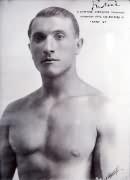
The men's artistic individual all-around event was part of the gymnastics programme at the 1932 Summer Olympics. It was the eighth appearance of the event, which was established in 1900. The competition was held from Monday, August 8, 1932, to Wednesday, August 10, 1932. Twenty-four gymnasts from five nations competed. Each nation could enter a team of 5 gymnasts; Hungary sent only 4. The event was won by Romeo Neri of Italy, the nation's first victory in the event since 1920 and fourth overall. István Pelle of Hungary took silver and Heikki Savolainen of Finland earned bronze; it was the first medal in the event for each nation.
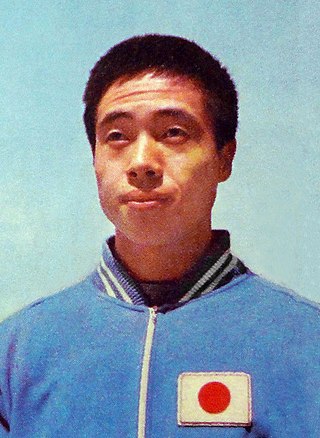
The men's parallel bars competition was one of eight events for male competitors in artistic gymnastics at the 1976 Summer Olympics in Montreal. The qualification and final rounds took place on July 18, 20, and 23rd at the Montreal Forum. There were 90 competitors from 20 nations, with nations competing in the team event having 6 gymnasts while other nations could have up to 3 gymnasts. The event was won by Sawao Katō of Japan, the first man to successfully defend an Olympic title in the parallel bars—and, as of the 2016 Games, still the only one to do so. It was the fourth consecutive victory by a Japanese gymnast in the event, breaking a tie with Switzerland for most all-time. Japan was unable to repeat its 1972 medal sweep, as nations were now limited to two finalists each. Nikolai Andrianov of the Soviet Union took silver, while Mitsuo Tsukahara of Japan earned bronze, missing a 1–2 finish for Japan by .025 points.

The men's parallel bars competition was one of eight events for male competitors in artistic gymnastics at the 1980 Summer Olympics in Moscow. The qualification and final rounds took place on July 20, 22 and 25th at the Luzhniki Palace of Sports. There were 65 competitors from 14 nations, with nations competing in the team event having 6 gymnasts while other nations could have to up to 3 gymnasts. The event was won by Aleksandr Tkachyov of the Soviet Union, the nation's first victory in the parallel bars since 1960 and third overall, tying Switzerland for second-most all-time behind Japan's four. Fellow Soviet Alexander Dityatin took silver, while Roland Brückner earned East Germany's first medal in the event. Japan's four-Games gold medal streak in the event ended with no Japanese gymnasts competing due to the American-led boycott.

The men's parallel bars competition was one of eight events for male competitors in artistic gymnastics at the 1968 Summer Olympics in Mexico City. There were 117 competitors from 28 nations, with nations in the team competition having up to 6 gymnasts and other nations entering up to 3 gymnasts. The event was won by Akinori Nakayama of Japan, the nation's second consecutive victory in the parallel bars event, tying Germany and the Soviet Union for second-most all-time behind Switzerland at three gold medals. It was the second of four straight Games that the parallel bars would be won by a Japanese gymnast. Mikhail Voronin took silver and Viktor Klimenko took bronze to put the Soviet Union back on the podium after a one-Games absence.

The men's parallel bars competition was one of eight events for male competitors in artistic gymnastics at the 1960 Summer Olympics in Rome. It was held on 5, 7, and 10 September at the Baths of Caracalla. There were 129 competitors from 28 nations, with nations in the team competition having up to 6 gymnasts and other nations entering up to 2 gymnasts. The event was won by Boris Shakhlin of the Soviet Union, the nation's second consecutive victory in the men's parallel bars. Giovanni Carminucci earned Italy's first medal in the event since 1932 with his silver. Takashi Ono of Japan took bronze for a second consecutive Games, making him the fourth man to win multiple medals in the event.

The men's horizontal bar competition was one of eight events for male competitors in artistic gymnastics at the 1956 Summer Olympics in Melbourne. There were 63 competitors from 18 nations, with nations in the team competition having up to 6 gymnasts and other nations entering up to 3 gymnasts. The event was won by Takashi Ono of Japan, with his countryman Masao Takemoto taking bronze. Silver went to Yuri Titov of the Soviet Union. Japan and the Soviet Union each earned their first horizontal bar medals.

The men's parallel bars competition was one of eight events for male competitors in artistic gymnastics at the 1956 Summer Olympics in Melbourne. It was held from 3 to 7 December at the Melbourne Festival Hall. There were 63 competitors from 18 nations, with nations in the team competition having up to 6 gymnasts and other nations entering up to 3 gymnasts. The event was won by Viktor Chukarin of the Soviet Union, the nation's first victory in the parallel bars. Japan took three medals: a silver by Masumi Kubota and bronzes by Takashi Ono and Masao Takemoto. It was the third time a nation had won three medals in the event in the same Games: the United States had swept the medals in 1904 and Switzerland had earned a gold and two bronzes in 1948. Chukarin was the third man to win multiple medals in the parallel bars; Ono would become the fourth in 1960.
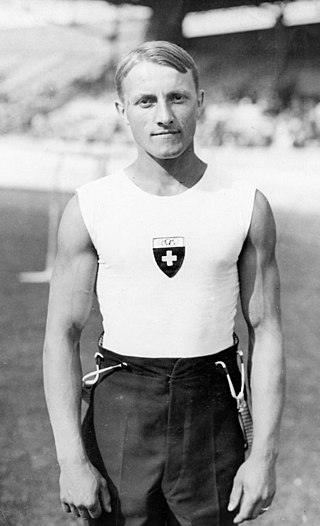
The men's horizontal bar event was part of the gymnastics programme at the 1928 Summer Olympics. It was one of seven gymnastics events for men and it was contested for the fourth time after 1896, 1904, and 1924. Scores from the horizontal bar event were added to the results from other individual apparatus events to give aggregate scores for the individual and team all-around events. There were 86 gymnasts from 11 nations, with each nation having a team of up to 8 gymnasts. The event was won by Georges Miez of Switzerland, the nation's first victory in the men's horizontal bar. The silver medal went to Romeo Neri of Italy, with Eugen Mack of Switzerland earning bronze.

The men's artistic individual all-around event was part of the gymnastics programme at the 1928 Summer Olympics. It was one of seven gymnastics events for men and was the seventh Olympic men's all-around gymnastic championship. Scores from the individual apparatus events were added to give aggregate scores for the individual all-around; individual all-around scores were similarly summed for the team all-around event. There were 88 competitors from 11 nations. Each nation sent a team of 8 gymnasts. The event was won by Georges Miez of Switzerland, with his countryman Hermann Hänggi taking silver. They were the first medals in the event for Swiss gymnasts since 1904 and the first gold medal ever for a Swiss man in the individual all-around. Defending Olympic champion Leon Štukelj of Yugoslavia finished with the bronze this time, making him the third man to win multiple medals in the event.

The men's parallel bars competition at the 1936 Summer Olympics was held at the Waldbühne on 10 and 11 August. It was the sixth appearance of the event. There were 110 competitors from 14 nations, with each nation sending a team of up to 8 men. The event was won by Konrad Frey of Germany, the nation's first victory in the event since 1896. Germany also took the bronze, as Alfred Schwarzmann finished third. Second place and the silver medal went to Michael Reusch of Switzerland. Germany was the first nation to have two gymnasts win the parallel bars.
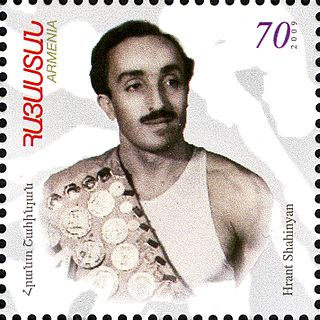
The men's artistic individual all-around competition at the 1952 Summer Olympics was held at Messuhalli, Exhibition Hall I from 19 to 21 July. It was the eleventh appearance of the event. There were 185 competitors from 29 nations. Each nation entered a team of between five and eight gymnasts or up to three individual gymnasts. The event was won by Viktor Chukarin of the Soviet Union, with his countryman Hrant Shahinyan taking silver. It was the Soviet debut in the event, beginning four decades of dominance rivalled only by Japan and ending after the dissolution of the Soviet Union; the Soviets would win 6 of the 10 editions from 1952 to 1988, with Japan taking the other 4. Bronze in 1952 went to Josef Stalder of Switzerland ; it was the last medal in the men's all-around for any gymnast not from the Soviet Union or Japan until 1980.

The men's vault competition at the 1948 Summer Olympics was held at Earls Court Exhibition Centre on 12 and 13 August. It was the seventh appearance of the event. There were 120 competitors from 16 nations, with each nation sending a team of up to 8 gymnasts. The event was won by Paavo Aaltonen of Finland with fellow Finn Olavi Rove finishing second; the medals were the nation's first in the men's vault. There was a three-way tie for third place resulting in three bronze medals being awarded to János Mogyorósi-Klencs and Ferenc Pataki of Hungary and Leo Sotorník of Czechoslovakia.

The men's horizontal bar competition at the 1948 Summer Olympics was held at Earls Court Exhibition Centre on 12 and 13 August. It was the seventh appearance of the event. There were 121 competitors from 16 nations, with each nation sending a team of up to 8 gymnasts. The event was won by Josef Stalder of Switzerland, with his countryman Walter Lehmann taking silver. It was the nation's second victory in the event, tying the United States for most all-time. Veikko Huhtanen of Finland earned bronze, giving Finland a three-Games podium streak in the event.
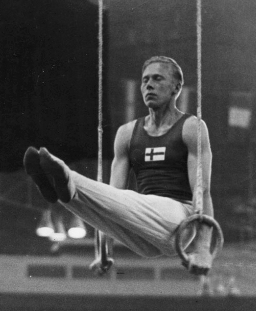
The men's parallel bars competition at the 1948 Summer Olympics was held at Earls Court Exhibition Centre on 12 and 13 August. It was the seventh appearance of the event. There were 122 competitors from 16 nations, with each nation sending a team of up to 8 gymnasts. The event was won by Michael Reusch of Switzerland, with his countrymen Christian Kipfer and Josef Stalder tying for bronze. Between the Swiss gymnasts was Veikko Huhtanen of Finland, taking silver. Reusch was the first man to win multiple medals in the event ; Stalder would become the second in 1952. It was Switzerland's second victory in the event, tying Germany for most gold medals.

The men's rings competition at the 1952 Summer Olympics was held at Töölö Sports Hall, Exhibition Hall I from 19 to 21 July. It was the eighth appearance of the event. There were 185 competitors from 29 nations, with each nation sending up to 8 gymnasts. The Soviet Union, in its debut in the event, won a medal of every color but did not quite sweep the medals as there was a tie for third. Hrant Shahinyan was the winner, Viktor Chukarin took silver, and Dmytro Leonkin shared bronze with Hans Eugster of Switzerland.
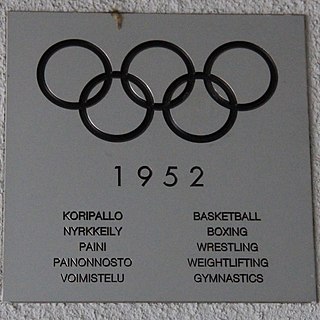
The men's pommel horse competition at the 1952 Summer Olympics was held at Töölö Sports Hall, Exhibition Hall I from 19 to 21 July. It was the eighth appearance of the event. There were 185 competitors from 29 nations, with each nation sending up to 8 gymnasts. The event was won by Viktor Chukarin as the Soviet Union swept the medals in its debut. It was the fourth medal sweep in the event, and last before apparatus finals with a two-gymnast-per-nation limit made further sweeps impossible. Yevgeny Korolkov and Hrant Shahinyan tied for silver.

The men's vault competition at the 1952 Summer Olympics was held at Töölö Sports Hall, Exhibition Hall I from 19 to 21 July. It was the eighth appearance of the event. There were 185 competitors from 29 nations, with nations competing in the team event entering up to 8 gymnasts and other nations able to send up to 3. The event was won by Viktor Chukarin of the Soviet Union, the nation's first medal in the event in its first appearance. Japan also earned its first medal(s): a silver and two bronzes, as Masao Takemoto finished second and there was a tie for third between Takashi Ono and Tadao Uesako.
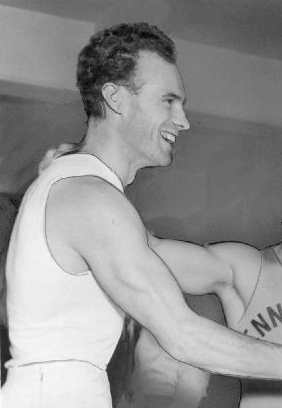
The men's horizontal bar competition at the 1952 Summer Olympics was held at Töölö Sports Hall, Exhibition Hall I from 19 to 21 July. It was the eighth appearance of the event. There were 185 competitors from 29 nations, with each nation sending up to 8 gymnasts. The event was won by Jack Günthard of Switzerland, the nation's second consecutive and third overall victory in the horizontal bar, breaking a tie with the United States for most all-time. Switzerland also took one of the silver medals, as Josef Stalder tied with Alfred Schwarzmann of Germany, competing at the age of 40, for second. Stalder and Schwarzmann were the first two men to win multiple horizontal bars medals; Stalder had won the event in 1948 and Schwarzmann had earned bronze in 1936.
















